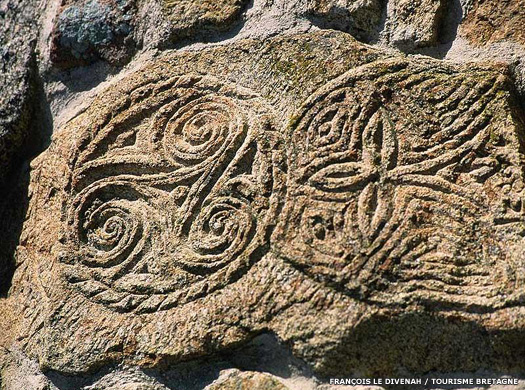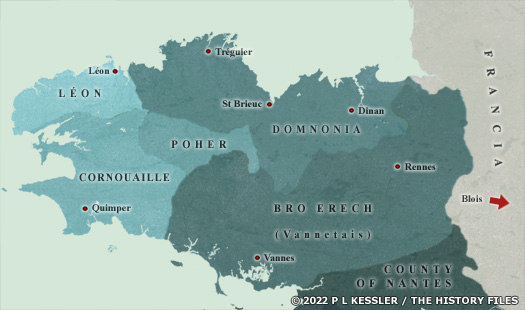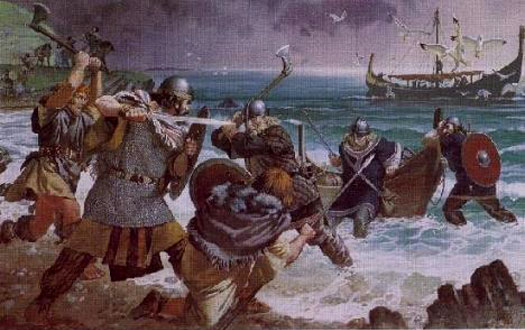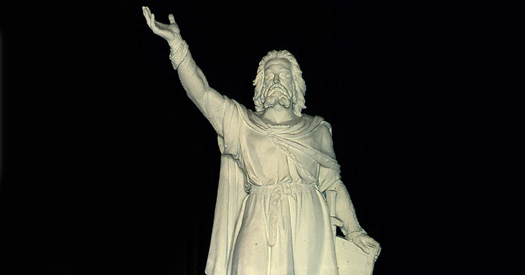 |
|
|
| (Information by Peter Kessler, with additional information by Geoffrey Tobin and Edward Dawson, from Brittany: Many Kingdoms or One?, Jean-Michel Pognat, from Province and Empire: Brittany and the Carolingians, Julia M H Smith, part of The Cambridge Studies in Medieval Life and Thought series (1992), from The Ethnology of Germany Part 3: The Migration of the Saxons, Henry H Howorth (Journal of the Anthropological Institute of Great Britain and Ireland, Vol 7, 1878), from The History of the Franks, Volume II, Gregory of Tours (O M Dalton, Trans, 1967), from The History of Normandy and of England, Francis Palgrave (1864), from English Historical Documents c.500-1042: Chronicle of Nantes (Chapter 27), Dorothy Whitelock (Ed, Second Edition, 1979), from La Bretagne des saints et des rois - Ve-Xe siècles, André Chédeville (1984), from Petite histoire du Grand Poher, Christian Y M Kerboul (2000), and from External Link: Flags of the World.) |
|
|
| fl c.520 |
Cyn-March ap Meirchion / Mark |
King of Cornubia. Also prince of Poher? |
| fl c.540 |
Conomor / Cunomorus 'the Cursed' |
Prince of Poher. Usurper king of Domnonia. Killed in battle. |
| 540s |
Conomor's name means 'great dog'. In the Life of St Pol de Leon (St Paul Aurelian) completed in 883, there is a 'King Marc whose other name is Quonomorus', or Cunomorus, meaning 'hound of the sea'. This may be a confusion between this Conomor, prince of Poher and king of Domnonia and the Cyn-March ap Meirchion of Cornubia, or even the Marcus Conomari of Dumnonia, who had ruled in the early fifth century. It is hard to be sure if both Cyn-March and Conomor hold any power in Poher, or if the former is merely present due to the aforementioned confusion.  The migrating Britons would have entered a landscape which was littered with the relics of their continental Celtic cousins, including this rock inscription within Poher's territory The migrating Britons would have entered a landscape which was littered with the relics of their continental Celtic cousins, including this rock inscription within Poher's territory |
|
| Conomor is said to emigrate from Britain into the Vannetais in the first half of the sixth century, and then to build a castle at Carhaix. Breton tradition presents Conomor as a local 'bluebeard' who does not spare the life of his last wife. When threatened by his rival Breton warlords and abbots, he seeks help from Childebert, king of the Franks of Paris, but is killed around 560 in a battle against Chlotar, Childebert's more powerful superior. |
|
|
| After this point, Poher seems either to be ruled directly as part of the Breton king's territories or is subsumed within Cornouaille or Domnonia (the latter likely as its king is restored to his own throne following the death of Conomor). The core territory may still be governed by a local clan or warband and its chief, but no names have been recorded by history. |
|
|
| c.830s? |
According to Hubert Guillotel (in Chédeville's La Bretagne des saints et des rois - Ve-Xe siècles), the first count of Poher is Rivelen. Whether or not he is the same individual as the near-contemporary count of Cornouaille is unclear, but he is succeeded by his better-attested brother, Nominoë, count of Vannes.  Vannetais was created during the late fourth century AD, enjoying a peak of expansion and power up until 491 (click or tap on map to view full sized) Vannetais was created during the late fourth century AD, enjoying a peak of expansion and power up until 491 (click or tap on map to view full sized) |
|
| Rivelen / Riwallon / Rivallon |
Count of Poher. |
|
| ? - 851 |
Nominoë / Nominoe |
Brother. Count of Vannes (& Poher?). First duke of Brittany? |
| 845 - 851 |
The ambitious Nominoë, count of Vannes, does not settle for only one victory in battle against Charles 'the Bald' (Charles-le-Chauve), new king of the [ Western Franks](../KingListsEurope/FranceFranks.htm#Western Franks). Instead he boldly goes on to conquer Rennes and Nantes (with the help and support of Lambert of Nantes), as well as the provinces of Maine and Anjou. Brittany reaches its greatest historical extent thanks to his conquests. |
|
| 851 - 857 |
Erispoe / Erispoë (the Younger) |
Son. Duke of Brittany. Count of Vannes (& Poher?). Murdered. |
| ? - 874? |
Ridoredh of Vannes |
Count of Vannes/Gwened (& Poher?). Prominent landowner. |
| 874 - 888 |
Ninth century Brittany is a very civilised place in which peasant property rights are enshrined in law and the powers of the prince (king or duke) are strictly limited. This is all undone when when Salaun is assassinated and the land overrun by Vikings. Breton rule is eventually restored under Alain 'the Great', but in the meantime, Gurvand rules in Rennes and Pascweten in Vannes, and both are claimants to the throne. Pascweten is Salaun's son-in-law and also one of his assassins, along with Gurvand, and Wigo son of Rivelen of Cornouialle (and possibly also Poher). Neither Gurvand or Pascweten are powerful enough to assume complete control so they fight it out amongst themselves for two years, and divide the country until both are dead. Pascweten's brother Alain continues the fight from Vannes against Judicaël of Rennes until the latter is killed when both team up to fight the Vikings. Alain now controls Brittany unopposed, although his numbering doesn't seem to account for two earlier Alains.  The Viking threat to Brittany was a very serious one, with the notorious Loire Vikings effectively occupying the duchy between 914-936, before finally being ejected The Viking threat to Brittany was a very serious one, with the notorious Loire Vikings effectively occupying the duchy between 914-936, before finally being ejected |
|
| 874 - 877 |
Pascweten / Pasquitan |
Son. Brother of Alain I of Brittany. Count of Vannes. |
| 877 - 907 |
Alain I |
Brother. Count of Vannes. |
| 907 |
The death of Alain 'the Great' results in instability in the land. With the succession again disputed, Gourmaëlon, count of Kernev, seizes power and declares himself 'Prince of Brittany'. Ownership of Vannes is unclear at this time but Rudalt seems to be the count until he is forced to flee by the Vikings. Alain's son-in-law, Mathuedoï, would seem to succeed him as count of Poher at the same time. In Nantes the name of the current count seems to be unknown, although it is likely that he is a [ Frankish](../KingListsEurope/FranceFranks.htm#Western Franks) appointee. |
|
| c.907 - 930 |
Mathuedoï / Malhuedoc I |
'Count of Poher'. m daughter of Alain I. Inherited Vannes? |
| 913/914 |
The Loire Vikings invade, slaying Count Gourmaëlon in battle and occupying Brittany. They establish their main naval base at the mouth of the Loire (at the southern edge of Brittany's lands), laying waste to Nantes, and then they use Brittany as a springboard for attacks on the [ Western Franks](../KingListsEurope/FranceFranks.htm#Western Franks) and the English (possibly in support of their kin in [East Anglia](EnglandEastAnglia.htm#Danish Kingdom)). Count Mathuedoï is married to the daughter of the late Alain 'the Great', and his son, Alan, is the godson of Edward 'the Elder', king of Wessex and the English. Mathuedoï puts to sea with a great multitude of Bretons and travels to meet Edward: 'this king had great trust in him because of this friendship and the alliance of this baptism'. Brought up from infancy with Æthelstan (Edward's eldest son), 'Alan is strong in body and very courageous, and does not care to kill wild boars and bears in the forest with an iron weapon, but instead uses a wooden staff'.  Mathuedoï's greatest claim to fame may be as the father of Alain II, duke of Brittany, Vannes, and Nantes, and count of Poher, who returned from exile to lead the Bretons to victory over the Loire Vikings and thereby recover the duchy Mathuedoï's greatest claim to fame may be as the father of Alain II, duke of Brittany, Vannes, and Nantes, and count of Poher, who returned from exile to lead the Bretons to victory over the Loire Vikings and thereby recover the duchy |
|
| 936 - 942 |
Having already encouraged a failed Breton rebellion against the Vikings, the monk Yann de Landévennec now calls on Alain to return to Brittany, which he does in 936 with the blessing and support of Æthelstan of [Wessex](EnglandWessex.htm#Kingdom United). Meanwhile, the future Hugh 'the Great' of Aquitaine is organising the return of Louis IV to [ France](../KingListsEurope/FranceFranks.htm#Western Franks). Alain's campaign against the Loire Vikings is successful and he is declared Duke Alain II. Then he allies himself with his cousin, Judicael of Nantes (called 'Berenger' by the Franks) and Count Hugh II of Maine to attack the Seine Vikings (the Normans). The presence of a powerful cousin in Nantes who bears a distinctive Late Romano-British/Breton name would strongly signal that this town is still part of Brittany. |
|
| 936 - 952 |
Alain II 'the Fox' |
Son. Count of Poher. Duke of Vannes & Nantes, and Brittany. |
| 952 |
With Alain 'the Fox' becoming duke of Brittany, Poher would seem to remain a possession of successive dukes. By the eleventh century Poher appears to have been handed down to a minor lord, Bernard, as viscount of Poher, possibly with links to the lords of Kernev. |
|
 |
|
|
 The low-key migration from Britain into Armorica seems to have picked up noticeably in the mid-fourth century, but it became a flood in the unsettled fifth century. Traditional certainly maintains that the British colony in Armorica was founded before the expedition of Constantine III in 407 (see feature link). People arrived mainly from the south-west of Britain, from Dumnonia and Cornubia, and each group retained its ethnic name (ergo the people in each region knew exactly what they were ethnically or tribally, regardless of who was king over them).
The low-key migration from Britain into Armorica seems to have picked up noticeably in the mid-fourth century, but it became a flood in the unsettled fifth century. Traditional certainly maintains that the British colony in Armorica was founded before the expedition of Constantine III in 407 (see feature link). People arrived mainly from the south-west of Britain, from Dumnonia and Cornubia, and each group retained its ethnic name (ergo the people in each region knew exactly what they were ethnically or tribally, regardless of who was king over them).  This new colony of Britons formed in a region which was beginning to drift out of firm Roman control. The colony's traditional first king, Conan Meriadog, ruled Armorica as the kingdom of Vannetais, maintaining the local Gaulish tribal name. The area was permanently 'freed' of Roman control by Magnus Maximus as the first stage of his invasion of Gaul in 383 (see feature link). Conan was placed in command, with a probable capital in Vannes. The usual Celtic practice of dividing territory between sons soon created the smaller principalities out of Vannetais during the course of the fifth and sixth centuries whilst other Britons also popped over from the mainland to found their own principalities. The precise location of the minor principality of Poher is uncertain. Linking it to the traditional county of today is not entirely reliable since ancient Poher is barely mentioned in official texts before the eleventh century. Either a position to the far east of Armorica or one within the borders of Cornouaille seems the most likely option according to varying sources (the latter choice has been accepted here). Set up by the new wave of British settlers during the mid-fifth century, Poher seemed to change hands a great deal from the sixth century onwards, between Britons and Franks after Blois had fallen in 491 and the Frankish border closed up to the Vannetais (Brittany) area. Its capital was Vorgium, the former Vorgium Osismiorum of the Osismii tribe (identified as modern Carhaix). It seemingly remained a stronghold even after the loss of Roman domination of the region. The origins of the principality's name have been interpreted in a good many ways, many of them incorrectly. Originally known as Pou Caër, this was an Old Breton name which was translated into Latin as 'pagus castrum' or 'pagus castelli'. The Latin word 'pagus' means 'rural' (and not 'people', as is occasionally given elsewhere). The Latin word for a peasant or a man of the rural farms (not the major estates) and the undeveloped countryside is 'paganus'. Therefore 'pagus castrum' means a fort in the countryside. The word 'castelli' is 'castrum' plus a diminutive, providing 'little fort'. Britons didn't seem to differentiate between the two, so therefore Pou Caër is simply 'Fort Pou'. The 'g' in pagus went silent in pronunciation (Powys underwent a similar process of naming from its initial form as Paganes). Diverging more from the straightforward approach, Chédeville (see below) believes that the name was derived from 'Ker Ahes', the source for the later Carhaix, with 'ker', meaning in Breton 'a domain' (from the Brythonic 'caer'), which would have been translated as 'a castle'. Kerboul and others suggest that 'caër' was indeed a fortified castle or a citadel which was built by Conomor in the sixth century.
This new colony of Britons formed in a region which was beginning to drift out of firm Roman control. The colony's traditional first king, Conan Meriadog, ruled Armorica as the kingdom of Vannetais, maintaining the local Gaulish tribal name. The area was permanently 'freed' of Roman control by Magnus Maximus as the first stage of his invasion of Gaul in 383 (see feature link). Conan was placed in command, with a probable capital in Vannes. The usual Celtic practice of dividing territory between sons soon created the smaller principalities out of Vannetais during the course of the fifth and sixth centuries whilst other Britons also popped over from the mainland to found their own principalities. The precise location of the minor principality of Poher is uncertain. Linking it to the traditional county of today is not entirely reliable since ancient Poher is barely mentioned in official texts before the eleventh century. Either a position to the far east of Armorica or one within the borders of Cornouaille seems the most likely option according to varying sources (the latter choice has been accepted here). Set up by the new wave of British settlers during the mid-fifth century, Poher seemed to change hands a great deal from the sixth century onwards, between Britons and Franks after Blois had fallen in 491 and the Frankish border closed up to the Vannetais (Brittany) area. Its capital was Vorgium, the former Vorgium Osismiorum of the Osismii tribe (identified as modern Carhaix). It seemingly remained a stronghold even after the loss of Roman domination of the region. The origins of the principality's name have been interpreted in a good many ways, many of them incorrectly. Originally known as Pou Caër, this was an Old Breton name which was translated into Latin as 'pagus castrum' or 'pagus castelli'. The Latin word 'pagus' means 'rural' (and not 'people', as is occasionally given elsewhere). The Latin word for a peasant or a man of the rural farms (not the major estates) and the undeveloped countryside is 'paganus'. Therefore 'pagus castrum' means a fort in the countryside. The word 'castelli' is 'castrum' plus a diminutive, providing 'little fort'. Britons didn't seem to differentiate between the two, so therefore Pou Caër is simply 'Fort Pou'. The 'g' in pagus went silent in pronunciation (Powys underwent a similar process of naming from its initial form as Paganes). Diverging more from the straightforward approach, Chédeville (see below) believes that the name was derived from 'Ker Ahes', the source for the later Carhaix, with 'ker', meaning in Breton 'a domain' (from the Brythonic 'caer'), which would have been translated as 'a castle'. Kerboul and others suggest that 'caër' was indeed a fortified castle or a citadel which was built by Conomor in the sixth century.
 The migrating Britons would have entered a landscape which was littered with the relics of their continental Celtic cousins, including this rock inscription within Poher's territory
The migrating Britons would have entered a landscape which was littered with the relics of their continental Celtic cousins, including this rock inscription within Poher's territory Vannetais was created during the late fourth century AD, enjoying a peak of expansion and power up until 491 (click or tap on map to view full sized)
Vannetais was created during the late fourth century AD, enjoying a peak of expansion and power up until 491 (click or tap on map to view full sized) The Viking threat to Brittany was a very serious one, with the notorious Loire Vikings effectively occupying the duchy between 914-936, before finally being ejected
The Viking threat to Brittany was a very serious one, with the notorious Loire Vikings effectively occupying the duchy between 914-936, before finally being ejected Mathuedoï's greatest claim to fame may be as the father of Alain II, duke of Brittany, Vannes, and Nantes, and count of Poher, who returned from exile to lead the Bretons to victory over the Loire Vikings and thereby recover the duchy
Mathuedoï's greatest claim to fame may be as the father of Alain II, duke of Brittany, Vannes, and Nantes, and count of Poher, who returned from exile to lead the Bretons to victory over the Loire Vikings and thereby recover the duchy